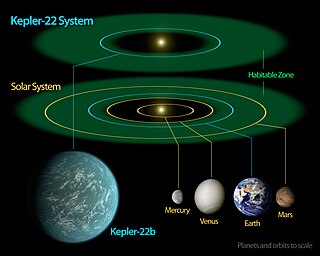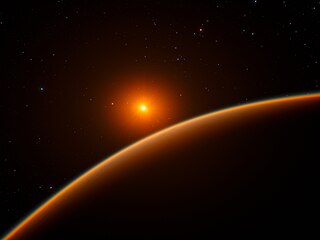Related Research Articles

Kepler-22b is an exoplanet orbiting within the habitable zone of the Sun-like star Kepler-22. It is located about 640 light-years from Earth in the constellation of Cygnus. It was discovered by NASA's Kepler Space Telescope in December 2011 and was the first known transiting planet to orbit within the habitable zone of a Sun-like star, where liquid water could exist on the planet's surface. Kepler-22 is too dim to be seen with the naked eye.

Kepler-20f (also known by its Kepler Object of Interest designation KOI-070.05) is an exoplanet orbiting the Sun-like star Kepler-20, the second outermost of five such planets discovered by NASA's Kepler spacecraft. It is located approximately 929 light-years (285 parsecs, or about 8.988×1015 km) from Earth in the constellation Lyra. The exoplanet was found by using the transit method, in which the dimming effect that a planet causes as it crosses in front of its star is measured. The planet is notable as it has the closest radius to Earth known so far.

Kepler-69c is a confirmed super-Earth extrasolar planet, likely rocky, orbiting the Sun-like star Kepler-69, the outermore of two such planets discovered by NASA's Kepler spacecraft. It is located about 2,430 light-years from Earth.

Kepler-62 is a K-type main sequence star cooler and smaller than the Sun, located roughly 980 light-years from Earth in the constellation Lyra. It resides within the field of vision of the Kepler spacecraft, the satellite that NASA's Kepler Mission used to detect planets that may be transiting their stars. On April 18, 2013, it was announced that the star has five planets, two of which, Kepler-62e and Kepler-62f are within the star's habitable zone. The outermost, Kepler-62f, is likely a rocky planet.

Kepler-62e is a super-Earth exoplanet discovered orbiting within the habitable zone of Kepler-62, the second outermost of five such planets discovered by NASA's Kepler spacecraft. Kepler-62e is located about 990 light-years from Earth in the constellation of Lyra. The exoplanet was found using the transit method, in which the dimming effect that a planet causes as it crosses in front of its star is measured. Kepler-62e may be a terrestrial or ocean-covered planet; it lies in the inner part of its host star's habitable zone.

Kepler-62f is a super-Earth exoplanet orbiting within the habitable zone of the star Kepler-62, the outermost of five such planets discovered around the star by NASA's Kepler spacecraft. It is located about 980 light-years from Earth in the constellation of Lyra.
Kepler-62c is an approximately Mars-sized exoplanet discovered in orbit around the star Kepler-62, the second innermost of five discovered by NASA's Kepler spacecraft around Kepler-62. At the time of discovery it was the second-smallest exoplanet discovered and confirmed by the Kepler spacecraft, after Kepler-37b. It was found using the transit method, in which the dimming that a planet causes as it crosses in front of its star is measured. Its stellar flux is 25 ± 3 times Earth's. It is similar to Mercury.
Kepler-62b is the innermost and the second smallest discovered exoplanet orbiting the star Kepler-62, with a diameter roughly 30% larger than Earth. It was found using the transit method, in which the dimming effect that a planet causes as it crosses in front of its star is measured. It is likely to have an equilibrium temperature slightly higher than the surface temperature of Venus, high enough to melt some types of metal. Its stellar flux is 70 ± 9 times Earth's.
Kepler-61b is a super-Earth exoplanet orbiting within parts of the habitable zone of the K-type main-sequence star Kepler-61. It is located about 1,100 light-years from Earth in the constellation of Cygnus. It was discovered in 2013 using the transit method, in which the dimming effect that a planet causes as it crosses in front of its star is measured, by NASA's Kepler spacecraft.

Kepler-90h is an exoplanet orbiting within the habitable zone of the early G-type main sequence star Kepler-90, the outermost of eight such planets discovered by NASA's Kepler spacecraft. It is located about 2,840 light-years, from Earth in the constellation Draco. The exoplanet was found by using the transit method, in which the dimming effect that a planet causes as it crosses in front of its star is measured.

Kepler-442b is a confirmed near-Earth-sized exoplanet, likely rocky, orbiting within the habitable zone of the K-type main-sequence star Kepler-442, about 1,206 light-years (370 pc) from Earth in the constellation of Lyra.

Kepler-452b is a super-Earth exoplanet orbiting within the inner edge of the habitable zone of the sun-like star Kepler-452 and is the only planet in the system discovered by Kepler. It is located about 1,800 light-years (550 pc) from Earth in the constellation of Cygnus.

Kepler-452 is a G-type main-sequence star located about 1,800 light-years away from Earth in the Cygnus constellation. Although similar in temperature to the Sun, it is 20% brighter, 3.7% more massive and 11% larger. Alongside this, the star is approximately six billion years old and possesses a high metallicity. Thus, Kepler-452 can be considered a solar twin, although it could be considered a solar analog due to its age.

K2-3d, also known as EPIC 201367065 d, is a confirmed exoplanet of probable mini-Neptune type orbiting the red dwarf star K2-3, and the outermost of three such planets discovered in the system. It is located 137 light-years (42 pc) away from Earth in the constellation of Leo. The exoplanet was found by using the transit method, in which the dimming effect that a planet causes as it crosses in front of its star is measured. It was the first planet in the Kepler "Second Light" mission to receive the letter "d" designation for a planet. Its discovery was announced in January 2015.

Kepler-1229b is a confirmed super-Earth exoplanet, likely rocky, orbiting within the habitable zone of the red dwarf Kepler-1229, located about 870 light years from Earth in the constellation of Cygnus. It was discovered in 2016 by the Kepler space telescope. The exoplanet was found by using the transit method, in which the dimming effect that a planet causes as it crosses in front of its star is measured.
Kepler-1229 is a red dwarf star located about 870 light-years (270 pc) away from the Earth in the constellation of Cygnus. It is known to host a super-Earth exoplanet within its habitable zone, Kepler-1229b, which was discovered in 2016.

K2-72e (also known by its EPIC designation EPIC 206209135.04), is a confirmed exoplanet, likely rocky, orbiting within the habitable zone of the red dwarf star K2-72, the outermost of four such planets discovered in the system by NASA's Kepler spacecraft on its "Second Light" mission. It is located about 217.1 light-years (66.56 parsecs, or nearly 2.0538×1015 km) away from Earth in the constellation of Aquarius. The exoplanet was found by using the transit method, in which the dimming effect that a planet causes as it crosses in front of its star is measured.

LHS 1140 b is a massive, dense rocky planet orbiting within the conservative habitable zone of the red dwarf LHS 1140. Discovered in 2017 by the MEarth Project, LHS 1140 b is nearly 7 times the mass of Earth and over 60% larger in radius, putting it within the Super-Earth category of planets. It is one of the densest planets found, with a density almost twice that of Earth, along with a high surface gravity of about 2.41 Earth's. LHS 1140 b orbits entirely within the star's habitable zone and gets 41% the incident flux of Earth. The planet is only 40 light-years away and transits its star, making it an excellent candidate for atmospheric studies with ground-based and/or space telescopes.

Kepler-90i (also known by its Kepler Object of Interest designation KOI-351.08) is a super-Earth exoplanet with a radius 1.32 times that of Earth, orbiting the early G-type main sequence star Kepler-90 every 14.45 days, discovered by NASA's Kepler spacecraft. It is located about 2,840 light-years (870 parsecs, or nearly 2.4078×1016 km) from Earth in the constellation Draco. The exoplanet is the eighth in the star's multiplanetary system. As of December 2017, Kepler-90 is the star hosting the most exoplanets found. Kepler-90i was found with the transit method, in which the dimming effect that a planet causes as it crosses in front of its star is measured, and by a newly utilized computer tool, deep learning, a class of machine learning algorithms.
Kepler-737b is a super-Earth exoplanet 669 light years away. There is a chance it could be on the inner edge of the habitable zone.
References
- 1 2 3 4 5 6 7 8 9 10 11 12 13 14 15 16 17 Borucki, William J.; et al. (18 April 2013). "Kepler-62: A Five-Planet System with Planets of 1.4 and 1.6 Earth Radii in the Habitable Zone". Science Express. 340 (6132): 587–90. arXiv: 1304.7387 . Bibcode:2013Sci...340..587B. doi:10.1126/science.1234702. PMID 23599262. S2CID 21029755.
- 1 2 NASA Kepler Discovers New Potentially Habitable Exoplanets Archived 2019-10-21 at the Wayback Machine Abel Mendez. April 18, 2013. Retrieved August 10, 2016.
- ↑ Fraser Cain (16 September 2008). "How Old is the Sun?". Universe Today . Retrieved 19 February 2011.
- ↑ Fraser Cain (15 September 2008). "Temperature of the Sun". Universe Today. Retrieved 19 February 2011.




